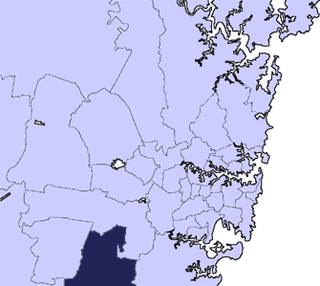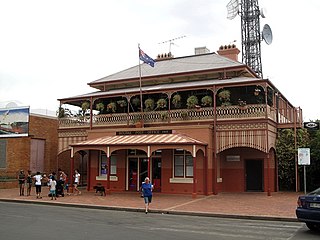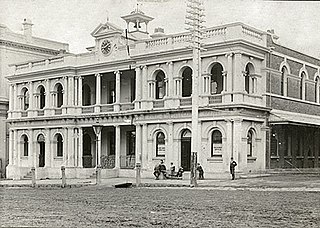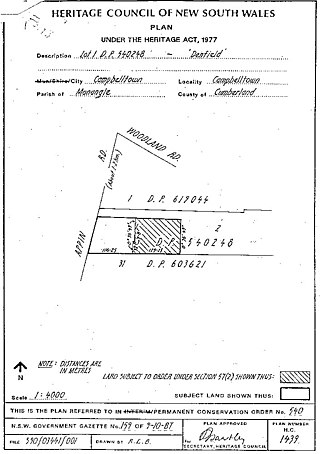
Campbelltown is a suburb located on the outskirts of the metropolitan area of Sydney, New South Wales, Australia. It is located in Greater Western Sydney 53 kilometres (33 mi) south-west of the Sydney central business district by road. Campbelltown is the administrative seat of the local government area of the City of Campbelltown. It is also acknowledged on the register of the Geographical Names Board of New South Wales as one of only four cities within the Sydney metropolitan area.

The City of Campbelltown is a local government area in the Macarthur region of south-western Sydney, in New South Wales, Australia. The area is located about 55 kilometres (34 mi) south west of the Sydney central business district and comprises 312 square kilometres (120 sq mi).

Appin is a town on the south-west fringe of Sydney in the Macarthur Region in Tharawal country near its boundary with Gandangara country, New South Wales, Australia in Wollondilly Shire. It is situated about 16 kilometres (9.9 mi) south of Campbelltown and 35 kilometres (22 mi) northwest of Wollongong.

The Department of Lands building is a heritage-listed state government administrative building of the Victorian Renaissance Revival architectural style located in Bridge Street in the Sydney central business district of New South Wales, Australia. The large three-storey public building was designed by Colonial Architect James Barnet and built in different stages, with Walter Liberty Vernon and William Edmund Kemp designing various components of the building. The builder was John Young.

The Wellington Post Office is a heritage-listed post office located at 21 Maughan Street, Wellington in the Dubbo Regional Council local government area of New South Wales, Australia. It was designed by Colonial Architect’s Office, under the direction of James Barnet, and built between 1869 and 1904. The property, which is owned by Australia Post, was added to the New South Wales State Heritage Register on 22 December 2000.

Bourke Post Office is a heritage-listed post office at 47 Oxley Street, Bourke, in the Orana region of New South Wales, Australia. It was designed by the Colonial Architect's Office under James Barnet and built in 1880 by E. Heseler. It is also known as Bourke Post and Telegraph Office. The property is owned by the Keane Family Trust. It was added to the New South Wales State Heritage Register on 23 June 2000.

Broken Hill Post Office is a heritage-listed post office at 258–260 Argent Street, Broken Hill, in the Far West of New South Wales, Australia. The original building was designed by James Barnet, and was built from 1890 to 1892 by John Dobbie. Walter Liberty Vernon designed a telegraph office addition in 1900. The property is owned by Australia Post. It was added to the New South Wales State Heritage Register on 22 December 2000. It was added to the Australian Commonwealth Heritage List on 08 November 2011.

Forbes Post Office is a heritage-listed post office at 118 Lachlan Street, Forbes, Forbes Shire, New South Wales, Australia. It was designed by the New South Wales Colonial Architect's Office under James Barnet and built from 1879 to 1881 by P. M. Vaughan. The property is owned by Australia Post. It was added to the New South Wales State Heritage Register on 22 December 2000. It was added to the Australian Commonwealth Heritage List on 22 June 2004.

The Tenterfield Post Office is a heritage-listed post office located at 225 Rouse Street, Tenterfield, Tenterfield Shire, New South Wales, Australia. It was designed by NSW Colonial Architect's Office under James Barnet and built from 1881 to by T. & J. McGuaran, later T. A. Lewis. It is also known as the Tenterfield Post Office and Quarters. The property is owned by Australia Post. It was added to the New South Wales State Heritage Register on 17 December 1999.

The Tamworth Post Office is a State heritage-listed post office located on the corner of Fitzroy Street and Peel Street, Tamworth in the Tamworth Regional Council local government area of New South Wales, Australia. It was designed by the Colonial Architect's Office under James Barnet and built by W. C. Cains. The property is owned by Australia Post and was added to the New South Wales State Heritage Register on 22 December 2000.

Kiama Post Office is a heritage-listed post office at 24 Terralong Street, Kiama, Municipality of Kiama, New South Wales, Australia. It was designed by the Colonial Architect's Office under James Barnet. and built by W. R. Vaughan. The property is owned by Australia Post. It was added to the New South Wales State Heritage Register on 22 December 2000.

The Orange Post Office is a heritage-listed post office located at 221 Summer Street, Orange, City of Orange, New South Wales, Australia. It was designed by Designed by the Colonial Architect’s Office under James Barnet and built by J. Douglas. The property is owned by Australia Post. It was added to the New South Wales State Heritage Register on 22 December 2000.

The North Sydney Post Office is a heritage-listed post office located at 92-94 Pacific Highway, North Sydney, North Sydney Council, New South Wales, Australia. It was designed by the Colonial Architect’s Office under the direction of James Barnet, and built from 1885 to 1889 by James Reynolds. The property is owned by Australia Post, an agency of the Australian Government. It was added to the New South Wales State Heritage Register on 22 December 2000.

Richmond Post Office is a heritage-listed former post office at 286 Windsor Street, Richmond, City of Hawkesbury, New South Wales, Australia. It was designed by Colonial Architect James Barnet and built from 1875 to 1888. The original building was built by a Mr. Johnson, with the second-story addition in 1888 added by Samuel Bought. It is also known as Richmond Telegraph and Post Office. It was added to the New South Wales State Heritage Register on 23 June 2000.

Dredges Cottage is a heritage-listed former cottage and now office located at 303 Queen Street, Campbelltown in the City of Campbelltown local government area of New South Wales, Australia. The property is owned by Campbelltown City Council. It was added to the New South Wales State Heritage Register on 2 April 1999.

Commercial Banking Company of Sydney (CBC), Campbelltown Branch is a heritage-listed former restaurant, offices and bank building and now medical centre located at 263 Queen Street, Campbelltown in the City of Campbelltown local government area of New South Wales, Australia. It was designed by Mansfield Brothers and built from 1874 to 1881. It is also known as Old CBC Bank; CBC Bank. The property is privately owned. It was added to the New South Wales State Heritage Register on 2 April 1999.

Warbys Barn and Stables is a heritage-listed former barns and now commercial building at 14 - 20 Queen Street, Campbelltown in the City of Campbelltown local government area of New South Wales, Australia. It was designed by John Warby and built in 1816. It is also known as Warbys Barn and Warbys Stables, The Leumeah Barn, Leumeah Barn Restaurant and Campbelltown Motor Inn. It was added to the New South Wales State Heritage Register on 2 April 1999.

Queen Street Buildings are a group of heritage-listed former shops and hotel at 284 - 298 Queen Street, Campbelltown in the City of Campbelltown local government area of New South Wales, Australia: built by John Doyle (hotel), William Bursill and Cobb and Bocking. It is also known as Queen Street Buildings Group, McGuanne House, Old Railway Hotel, William Bursill's Shop and The Coach House. The property is owned by Minister For Administering The Environmental & Planning Act, 1979. It was added to the New South Wales State Heritage Register on 2 April 1999.

Denfield is a heritage-listed former farm homestead complex, residence, inn and farm and now residence located at Appin Road, St Helens Park in the City of Campbelltown local government area of New South Wales, Australia. It was built in 1837 by John Farley. It was added to the New South Wales State Heritage Register on 2 April 1999.

Redfern Post Office is a heritage-listed former residence and now post office located at 113 Redfern Street in the inner western Sydney suburb of Redfern in the City of Sydney local government area of New South Wales, Australia. It was designed by the Colonial Architect’s Office under James Barnet and built by Goddard and Pittman. The property is owned by Australia Post, an agency of the Australian Government. It was added to the New South Wales State Heritage Register on 22 December 2000.





















